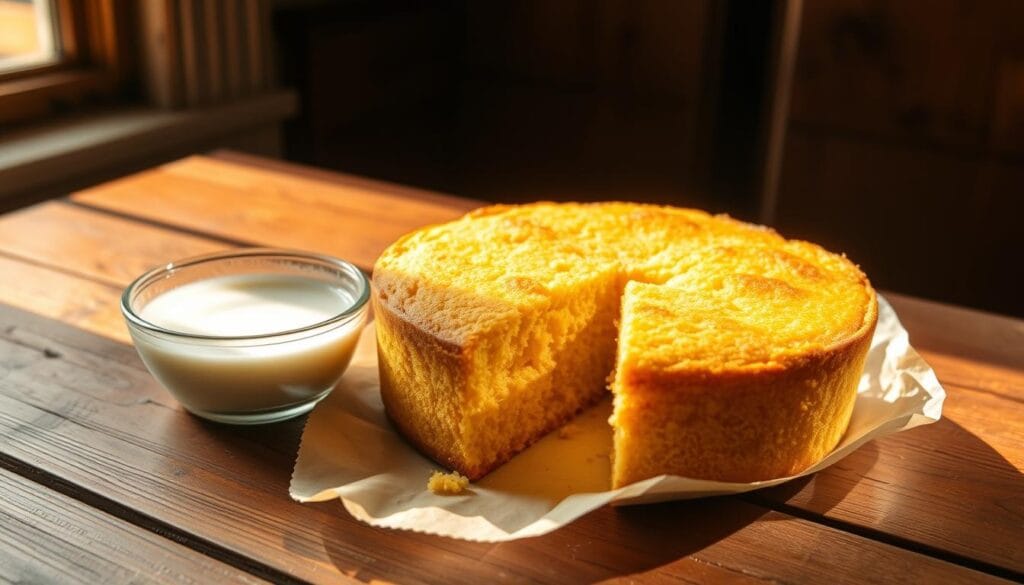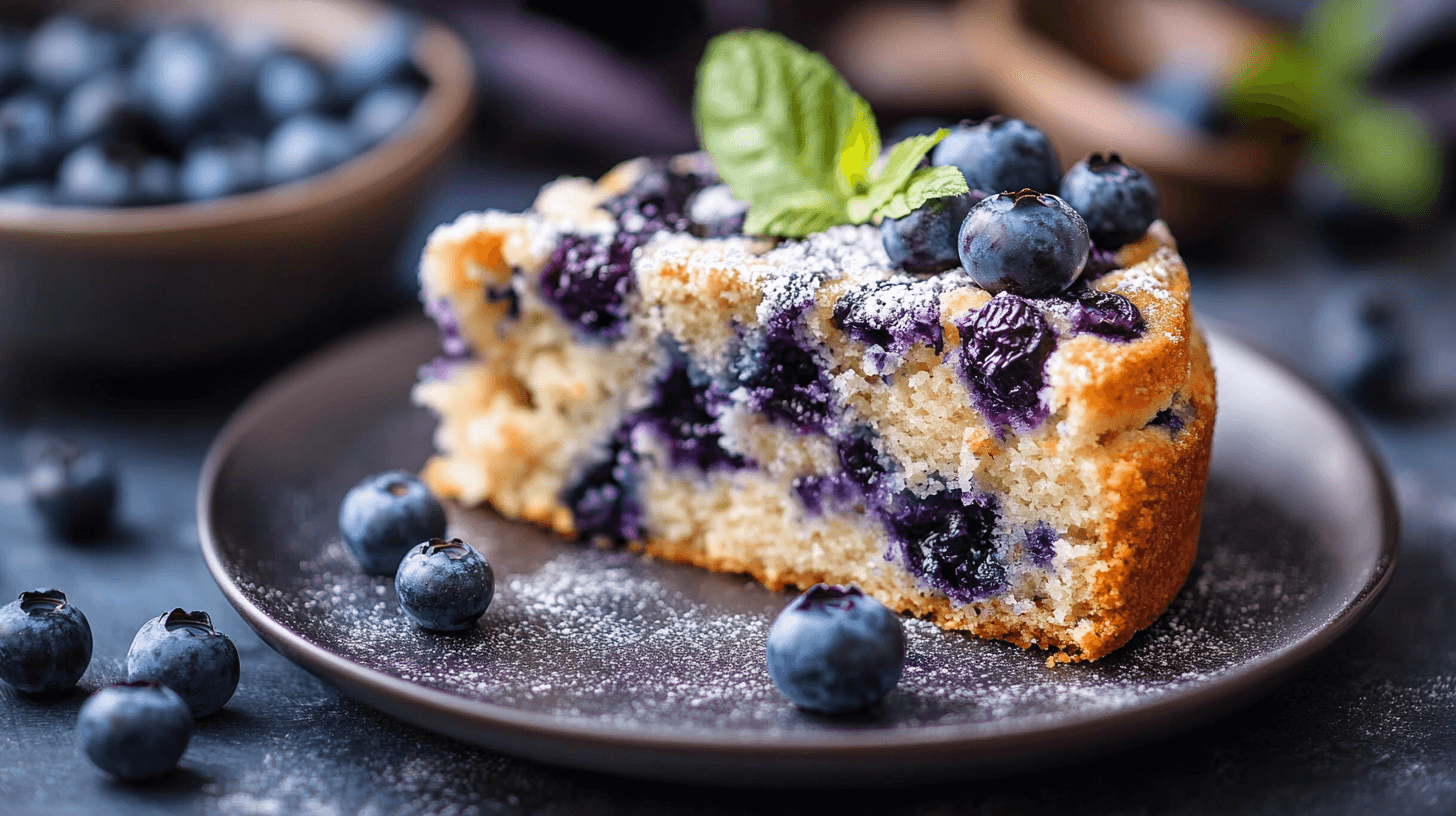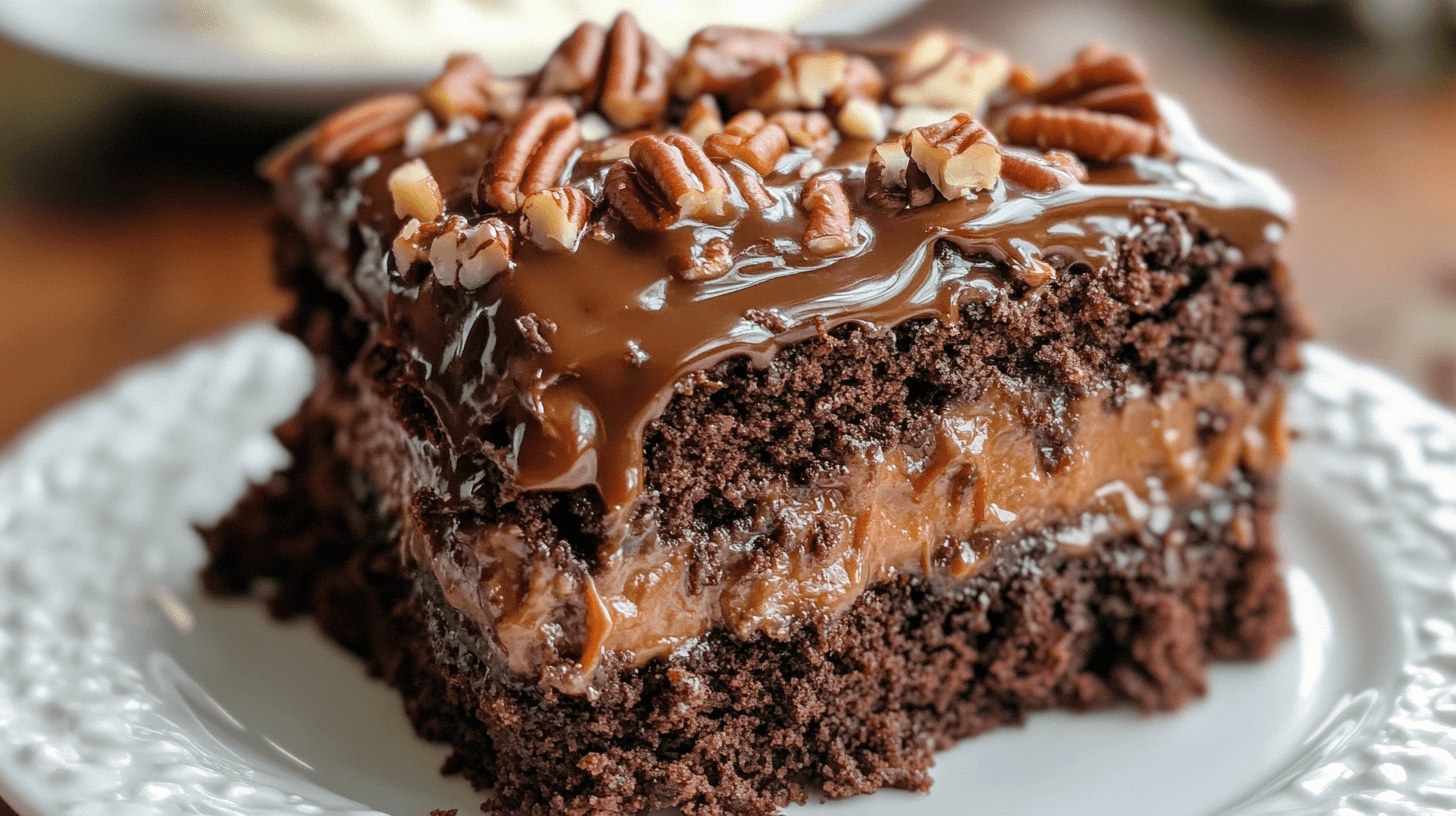What is cornbread and milk called? This simple yet beloved dish is a cherished tradition in the American South. Mark Twain once praised Southern cornbread as the finest bread in the world, and the act of crumbling warm cornbread into a cold glass of milk holds a special place in Southern hearts and homes. Discover what makes this humble pairing so uniquely comforting and iconic.
Let’s dive into the history, regional flavors, and cultural importance of this comfort food. It’s a story of tradition and taste that brings people together.
Table of Contents
Understanding the Southern Tradition of Cornbread and Milk
Cornbread has been a key part of traditional Southern cuisine for centuries. It comes from Native American cooking traditions. Early European settlers added flour, baking powder, and eggs to make the Southern cornbread we love today.
Origins of the Comfort Food Combination
The mix of cornbread and milk started as a simple, affordable meal. It needed just cornmeal and a dairy cow, common in Southern households. This combo became a cultural heritage and a beloved comfort food, loved by many generations.
Regional Variations and Names
In the Southern United States, cornbread and milk has many names and ways of making it. From the tangy buttermilk cornbread of Appalachia to the sweeter versions in the Carolinas, it shows the unique tastes of each Southern community.
Cultural Significance in Southern Households
Cornbread and milk is more than just a traditional dish in the South. It’s a symbol of family bonding and celebrating Southern heritage. Sharing this meal helps families keep memories and traditions alive.
“Cornbread and milk is a quintessential Southern comfort food that evokes a sense of home and belonging. It’s a tradition that has endured for generations, weaving its way into the very fabric of our regional cuisine and cultural identity.”
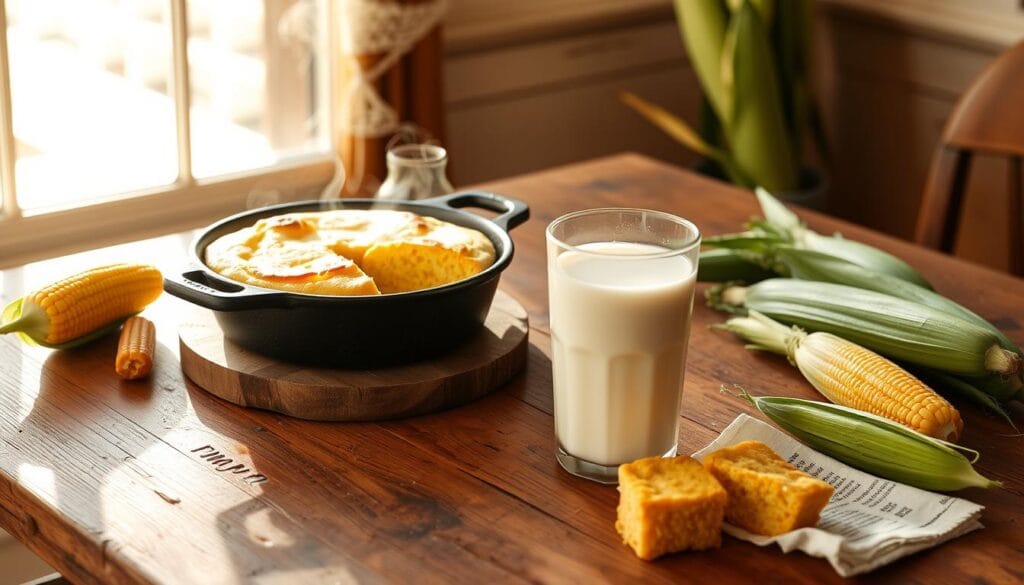
What is Cornbread and Milk Called: Southern Terms and Nicknames
In the Southern United States, people love to mix crumbled cornbread with cold milk. This combo is known by many names and nicknames. It shows the rich food traditions and local tastes that have been shared for years.
“Crumble In” is a common term for this dish. It’s about crumbling cornbread into a glass of cool milk. The mix of soft crumbs and cool milk is very satisfying.
In some areas, it’s called “Cornbread Dip” or “Cornbread Soak.” These names point out how the cornbread soaks up the milk, making it creamy and comforting.
Other names include “Bread and Milk,” “Crumbly Bread and Milk,” and “Cornbread Cereal.” These names show how simple and flexible this Southern dish is. It’s great as a snack, side dish, or light meal.
Despite different names, enjoying cornbread and milk brings people together. It connects generations of Southerners, showing the lasting love for this comfort food.
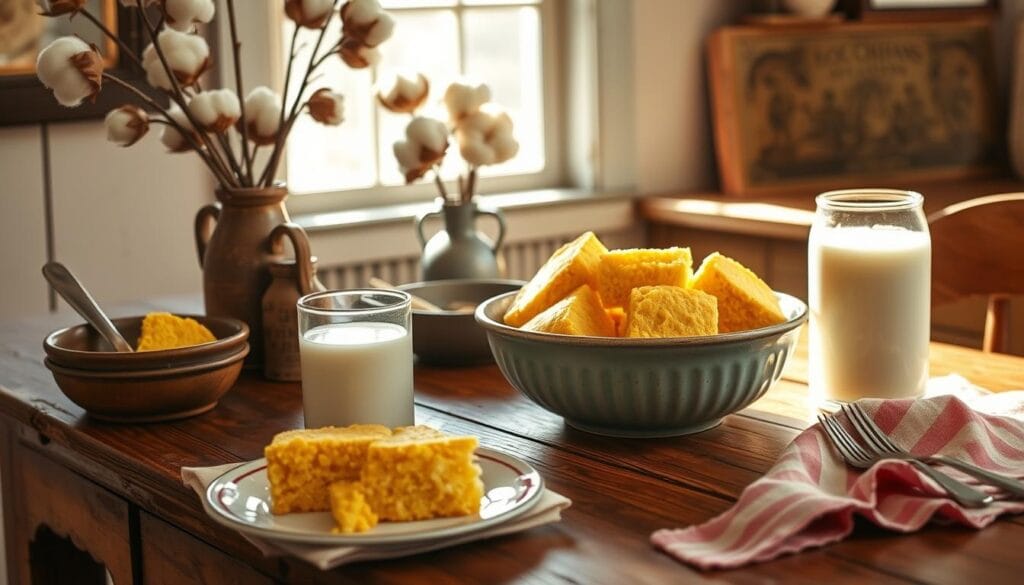
| Southern Term | Regional Variation |
|---|---|
| Crumble In | Cornbread Dip, Cornbread Soak |
| Bread and Milk | Crumbly Bread and Milk, Cornbread Cereal |
The Art of Making Traditional Southern Cornbread
Making the perfect Southern cornbread is a skill that’s been passed down for generations. It’s a key part of comfort food and a favorite in many homes. To get the real taste and texture, there are a few important things to remember.
Essential Ingredients for Authentic Cornbread
The base of a true Southern cornbread recipe is self-rising cornmeal mix. Unlike Northern cornbread, which often has sugar, Southern cornbread doesn’t. It focuses on the deep, savory taste of the cornmeal.
The recipe also includes all-purpose flour, brown sugar, baking powder, baking soda, salt, milk or buttermilk, eggs, and melted butter or oil.
The Importance of Cast Iron Skillets
A cast iron skillet is key for the perfect crispy crust of Southern cornbread. Cast iron holds heat well, making the cornbread’s outside golden and delicious.
Before adding the batter, heat the skillet with some oil. This ensures the cornbread cooks perfectly.
Tips for Achieving the Perfect Crust
To make your Southern cornbread even better, try these tips:
- Use White Lily self-rising cornmeal mix for a finer, more delicate texture.
- Add green onions or wild leeks (ramps) to the batter for a subtle, savory flavor.
- Preheat your cast iron skillet in the oven before adding the batter for a truly crisp crust.
With these tips, you’ll be on your way to making amazing Southern cornbread. It will make your taste buds happy and warm your heart.
North vs. South: The Great Cornbread Debate
The mix of cornbread and milk is a favorite in Southern cooking. But, there’s a big debate on the differences between Northern and Southern cornbread. Both areas love this simple dish, but their versions are quite different.
Southern cornbread is unsweetened, focusing on the cornmeal’s natural taste. It’s dense and crumbly, perfect with barbecue, fried chicken, and stewed greens. Northern cornbread, on the other hand, has sugar, making it sweeter and more like a cake. Some Southerners think this is wrong.
In the South, people love savory cornbread because of their culinary traditions. True Southerners do not put sugar in cornbread, preferring its savory taste and dense texture. They also bake it in a hot cast-iron skillet for a crispy edge.
| Characteristic | Northern Cornbread | Southern Cornbread |
|---|---|---|
| Sweetness | Often contains sugar for a sweeter taste | Unsweetened, emphasizing savory flavors |
| Texture | Cake-like and tender | Dense and crumbly |
| Cooking Method | Baked in a baking pan | Baked in a preheated cast-iron skillet |
| Pairing Dishes | Lighter, sweeter dishes | Hearty, savory dishes like barbecue and fried chicken |
The differences in cornbread styles show the variety in American cooking. Whether you like it sweet or savory, Northern or Southern, the debate over cornbread is exciting for food lovers everywhere.
Selecting the Right Milk for Your Cornbread
Choosing the right milk for cornbread is important. Buttermilk is a classic choice, adding a tangy flavor and soft texture. It also makes the cornbread tender. Sweet milk, on the other hand, has a milder taste. It’s great for those who want to enjoy the cornbread’s natural sweetness.
Buttermilk vs. Sweet Milk Options
The debate between buttermilk and sweet milk is long-standing in Southern kitchens. Buttermilk fans say it makes cornbread moist and flavorful. Sweet milk lovers prefer its clean taste. Milk alternatives like almond or oat milk are also gaining popularity in cornbread recipes.
Temperature Considerations
The temperature of the milk matters too. Some like their cornbread with cold milk for a refreshing contrast. Others prefer warm or room-temperature milk for better texture and flavor. It’s all about what you like best, so try different temperatures to find your favorite.
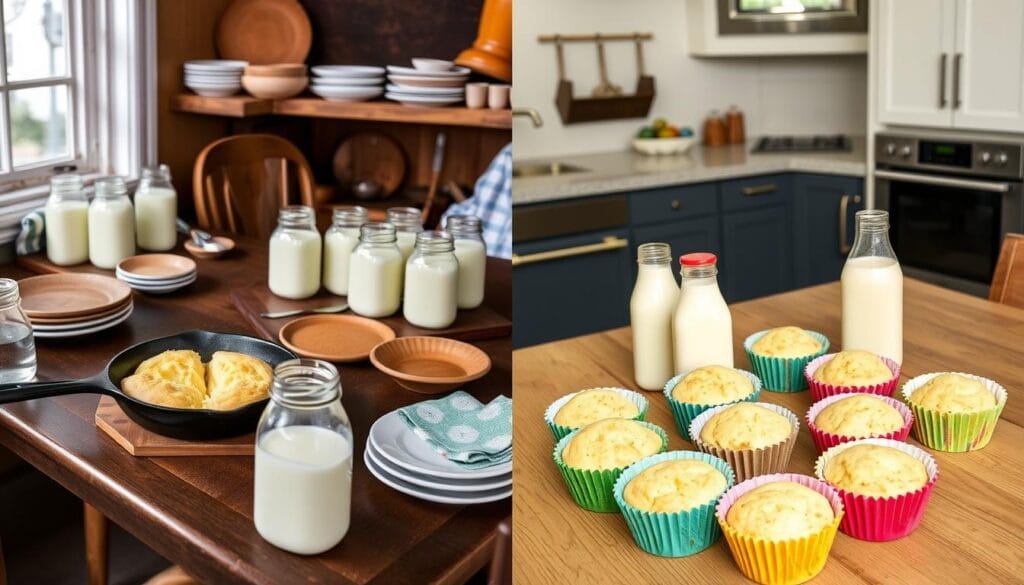
“The best cornbread is made with buttermilk, in my opinion. It just gives it that extra tang and moistness that sweet milk can’t quite replicate.”
Serving Styles and Preparation Methods-Cornbread and Milk
Cornbread and milk can be enjoyed in many ways. You might like it crumbled in a glass of cold milk or as a warm slice. This Southern dish has many serving suggestions and ways to prepare it, to match your taste.
One traditional way is to crumble cold cornbread into a glass of cool milk. This makes the cornbread absorb the milk, creating a tasty, spoonable texture. For a warmer experience, you can heat the cornbread lightly before crumbling it into the milk. This brings out the flavors and adds a cozy touch.
You can also add toppings to cornbread and milk. Try a drizzle of honey, a pat of butter, or a sprinkle of salt and pepper. These simple touches can make the dish more indulgent and satisfying.
Cornbread Variations
You can also customize the cornbread itself. Add jalapeños or shredded cheese for a savory twist, or blueberries or pumpkin puree for sweetness. These changes let you create a cornbread that pairs well with the milk, whether you like it traditional or modern.
No matter how you serve or modify cornbread and milk, enjoy every bite. Let the flavors mix and the textures blend on your tongue. This classic Southern dish is perfect for breakfast, a snack, or dessert, bringing joy and warmth to your day.
Health Benefits and Nutritional Value-Cornbread and Milk
Cornbread is more than a tasty Southern treat. It’s also a healthy whole grain option. Cornmeal, its main ingredient, is full of fiber, vitamins, and minerals. It includes B-complex vitamins, iron, magnesium, and phosphorus.
The carbs in cornbread give you energy slowly. This is because they are complex. This makes cornbread a good choice for keeping your energy up all day. The fiber in cornbread also helps your digestion. It keeps your bowels regular and feeds good bacteria in your gut.
Nutritional Components
Whole grains, like cornmeal, can lower heart disease risk. They help by lowering cholesterol and controlling blood pressure. Cornbread can also be made gluten-free. This makes it safe for people with gluten sensitivities or celiac disease.
Dietary Considerations
Comfort foods like cornbread also boost your mood. They give you a feeling of security and happiness. Adding cornbread to your meals helps you eat well. It provides important nutrients and can be paired with other healthy foods.
Whether you like traditional cornbread or gluten-free, it’s a tasty way to get the nutritional value, dietary benefits, and whole grain goodness from cornmeal.
Modern Twists on the Classic Combination
Modern chefs and home cooks are adding new twists to the classic cornbread and milk combo. They’re mixing in fresh recipes and exploring fusion cuisine. This opens up endless possibilities for reinventing this beloved dish.
One exciting twist is adding fresh blueberries to cornbread and milk. The sweet-tart berries pair well with the cornbread’s crumbly texture and sweet flavor. For a spicy kick, some recipes add melted cheese or diced jalapeños.
Using different milks is also a trend. Almond milk, oat milk, and coconut milk can replace traditional milk. This makes the dish accessible to those with dietary restrictions and adds a unique taste.
Chefs are also turning cornbread into desserts. Cornbread-based cakes, puddings, and ice creams mix sweet and savory. This creates a delightful blend of comfort and indulgence.
Another exciting twist is using cornbread as a base for trendy brunch dishes. Cornbread waffles, French toast, and benedict are just a few examples. These dishes elevate the classic combo to new heights, appealing to today’s tastes.
Whether you love traditional flavors or enjoy trying new things, there’s a lot to explore with cornbread and milk. From sweet treats to savory brunch dishes, these modern takes on a Southern classic are sure to impress and inspire.
Preserving and Storing Your Cornbread
Properly stored cornbread can be a delightful treat for days to come. Whether you’ve whipped up a fresh batch or have leftover slices, understanding the best storage methods is key. This ensures your cornbread stays moist and flavorful.
At room temperature, cornbread can last up to 3 days when stored correctly. To extend its shelf life, refrigeration is recommended. In the fridge, your cornbread can remain fresh for up to 5 days. However, refrigeration can lead to quicker drying, so be mindful of this when reheating.
For long-term storage, cornbread can be frozen for up to 3 months. To reheat frozen cornbread, simply wrap it in foil and warm it in a 325°F oven for about 10 minutes, or until heated through.
Leftover cornbread is a versatile ingredient that can be repurposed in various recipes. From cornbread salad to Southern cornbread dressing, your leftover slices can be transformed into delicious, comforting dishes.
| Storage Method | Shelf Life |
|---|---|
| Room Temperature | Up to 3 days |
| Refrigerator | Up to 5 days |
| Freezer | Up to 3 months |
Remember, the key to preserving your cornbread is to store it properly. Whether it’s at room temperature, in the fridge, or in the freezer. With a little care, you can enjoy the comforting flavors of this Southern staple for days or even weeks to come.
Conclusion
Cornbread and milk is a treasured southern tradition. It shows the region’s culinary heritage and resourcefulness. This simple dish brings back memories and comfort food for many Southerners. It also wins fans from all over the country.
The mix of fresh cornbread and creamy milk shows Southern cooks’ ingenuity. They turned simple ingredients into a beloved comfort food. This tradition reminds us of the rich culinary heritage that shapes the South’s food scene.
Enjoying cornbread and milk as a snack, meal, or family tradition connects Southerners to their roots. It celebrates the vibrant spirit of Southern cuisine. As more people love this classic dish, it becomes a key part of the South’s culinary heritage.
FAQ
What is cornbread and milk called?
In the Southern United States, cornbread and milk is known as “Crumble In.” It shows the region’s love for food and has its own special names.
What are the origins of cornbread and milk?
Cornbread comes from Native American maize cakes. European settlers made it their own, adding milk for a tasty, easy dish.
How is traditional Southern cornbread made?
Real Southern cornbread doesn’t have sugar. It uses self-rising cornmeal mix. A cast iron skillet is key for a crispy crust. Heat the skillet with oil before adding the batter.
What is the difference between Northern and Southern cornbread?
Southern cornbread is unsweetened. Northern cornbread often has sugar. This shows how different tastes and traditions vary by region.
Can both buttermilk and regular milk be used in cornbread and milk?
Yes, you can use buttermilk or regular milk. Buttermilk makes cornbread tangy and soft. Regular milk gives a different taste and texture.
How is cornbread and milk traditionally served?
It’s served in a glass or mason jar, not a bowl. Some like to crumble cold cornbread into milk. Others heat the cornbread first.
What are the health benefits of cornbread?
Cornbread is full of nutrients from whole grain cornmeal, like fiber. Buttermilk adds calcium and probiotics. Regular milk brings protein and vitamins, making it a healthy choice.
What are some modern variations of cornbread and milk?
Now, you can add fruits like blueberries or cheese for a savory twist. Some use alternative milks for dietary needs. Chefs also make cornbread-inspired desserts or use it in trendy brunch dishes.
How can cornbread be stored and reheated?
Cornbread stays fresh for 1-2 days at room temperature or up to a week in the fridge. For longer, freeze it for up to 3 months. To reheat, wrap in foil and warm in a 325°F oven for about 10 minutes.
“If you’re looking for a simple and flavorful dish, try this Easy Southern Cornbread Recipe with Beef Tallow for Beginners—perfect for any meal!”

